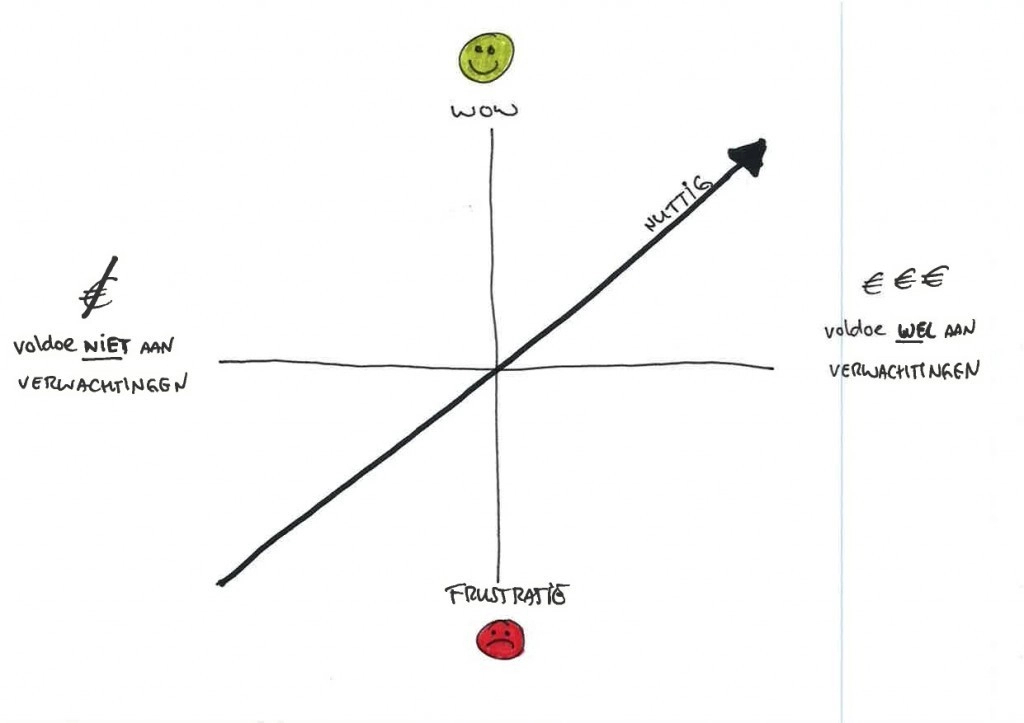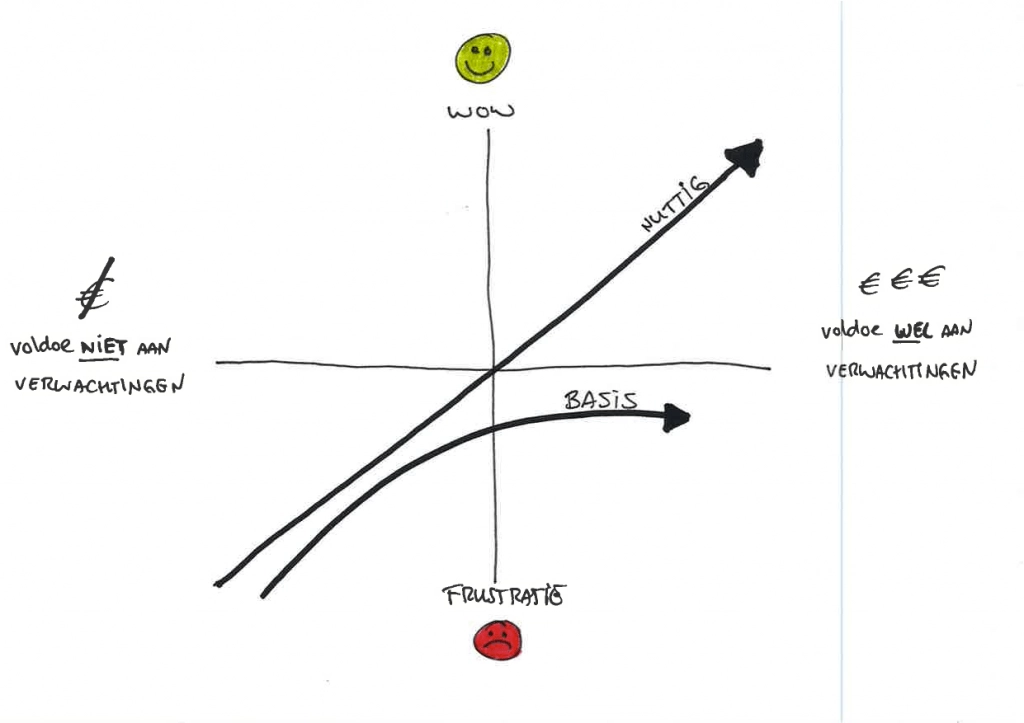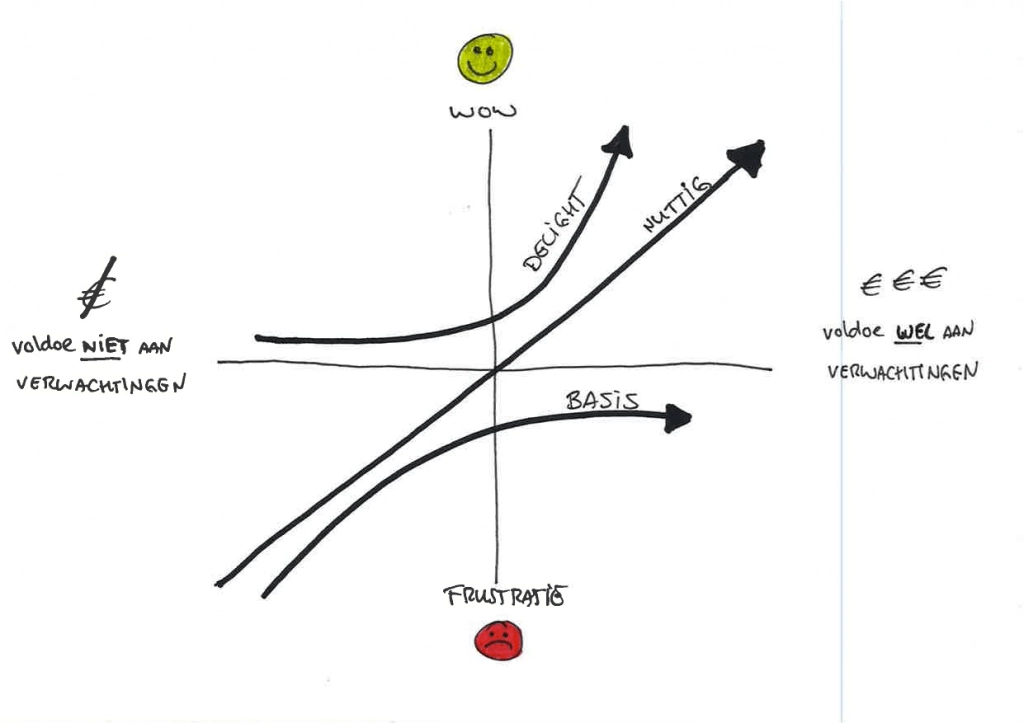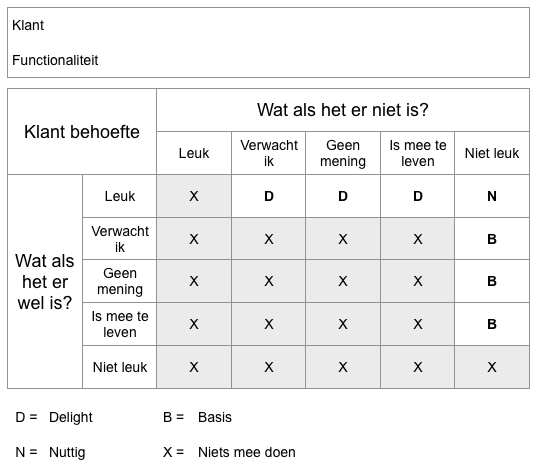Imagine, for instance interviews, observations, brainstorming sessions or benchmarks to identify your visitor's needs and expectations. You are then left with a whole list of functionalities. How do you proceed?
The canoe model helps you to classify these functionalities in such a way that you know which ones to implement as a minimum (basic), which are indispensable for further development (useful) and which can provide a wow experience (delight). You can visualise the three features in a model.

Useful features allow someone to achieve their goals even better and faster. They ensure strong satisfaction and are important for the further development of your site. Once the basics are in place, get straight to work on this.

The basic functionalities have to be in there as a minimum if you want to get anything off the ground at all. They do not create extreme satisfaction, but they do create extreme dissatisfaction if they are not in there. They have to be present on D-day. Think of it as the brakes of your car, a bed in a hotel room or salt in your dish.

The delight functionalities can make the difference, this is where the wow factor lies! If you don't put them in, there is little to worry about because people don't expect it. If you are smart and do it, you will exceed expectations and surprise people. It's the way to innovate.
Which label gets which functionality
To find out whether a functionality is 'basic', 'useful' or 'delight' you invite people and ask questions. Simple as that. There are two types of questions involved, namely:
1. What would you think if this functionality were in the website?
2. What would you think if this functionality was not in the website?
The response options are:
1. I would like that
2. I expect that
3. I have no opinion
4. I can live with that
4. I would not like that
For each participant, you fill in the table below and put it in a large spread sheet. You add up the answers of all participants per functionality and you know which label belongs to which functionality.

Example: salt in your dish
When you remove certain standard elements from an overall picture, it creates dissatisfaction. Salt, for example. If you remove that from a dish, everyone misses it. But if it's in there, no one says anything about it. They simply expect salt to be in the dish. It is a basic requirement. You can also add an extra ingredient to the dish that makes everyone love it. That's the wow factor.
Delighters provide the wow
You don't always just find out which functionalities are delight. After all, these are the functionalities that people do not expect; they are not spontaneously mentioned when you ask about them.
Take the little magnet on Apple's charger, the so-called 'magsafeclip'. Because the charger is attached to your MacBook with a little magnet, it won't fall to the ground if you trip over the wire. Brilliant. As a designer, you find this out by observing, for example; that you see people tripping over their charger and dropping the computer.
Example: salt in your dish
When you remove certain standard elements from an overall picture, it creates dissatisfaction. Salt, for example. If you remove that from a dish, everyone misses it. But if it's in there, no one says anything about it. They simply expect salt to be in the dish. It is a basic requirement. You can also add an extra ingredient to the dish that makes everyone love it. That's the wow factor.
Delighters provide the wow
You don't always just find out which functionalities are delight. After all, these are the functionalities that people do not expect; they are not spontaneously mentioned when you ask about them.
Take the little magnet on Apple's charger, the so-called 'magsafeclip'. Because the charger is attached to your MacBook with a little magnet, it won't fall to the ground if you trip over the wire. Brilliant. As a designer, you find this out by observing, for example; that you see people tripping over their charger and dropping the computer.

Because the charger is attached to your MacBook with a magnet, it won't fall to the ground if you trip over the wire (Zoooooo 2018).
Looking at the competitor
However, what is a delighter for one company is not for another. If Microsoft is going to recreate the 'magsafeclip' it does not (necessarily) create a wow. After all, it is already familiar and you just expect it to be on there. So at some point, a functionality ceases to be delight and becomes basic.
Have you thought of all kinds of delight features you want to put in site? Don't! First, see if the competition already offers them. If not, it is better to introduce them in stages. You are constantly looking ahead and thinking about which functionality you can best add at what time. Moreover, you take into account the investment for introducing the functionality.
Example: the monkey from Mailchimp
Mailchimp is a tool that lets you easily create digital newsletters. They have a monkey as their logo that says all kinds of funny things to you on the site. A clever functionality that creates a wow. It's not expensive to build and in terms of organisation it doesn't cost much either, but people like it!
The canoe model helps you decide whether a functionality is worth the investment. Introducing the Mailchimp monkey statements is a small investment with a high return. Conversely, we also see often enough that a functionality requires a high investment, while the visitor is neutral towards the functionality.
The canoe model: responding to the experience
We are fans of the canoe model! You are constantly reasoning from the user (and thus human-centred) point of view and can respond very accurately to the experience. So make sure all expected functionalities are present first and then go one step further, so that your target audience is amazed by the possibilities. Go for the wow factor!
Meld je aan voor onze nieuwsbrief en ontvang maandelijks praktische inzichten, tips en tricks om je op weg te helpen naar online groei!
Vul hieronder jouw e-mail in en ontvang direct een handig weetje 🙂
